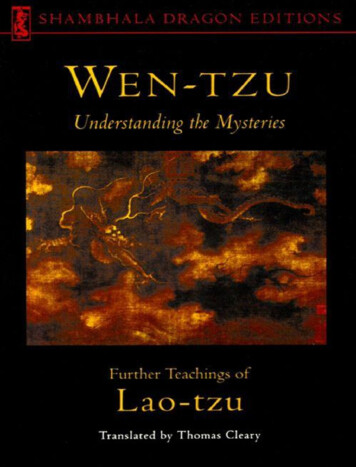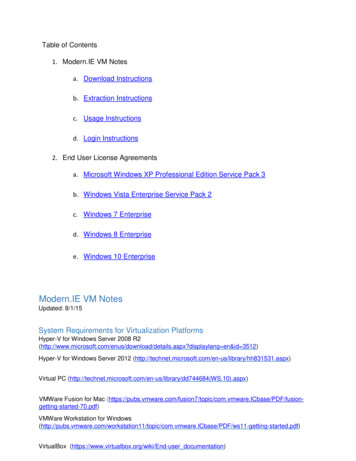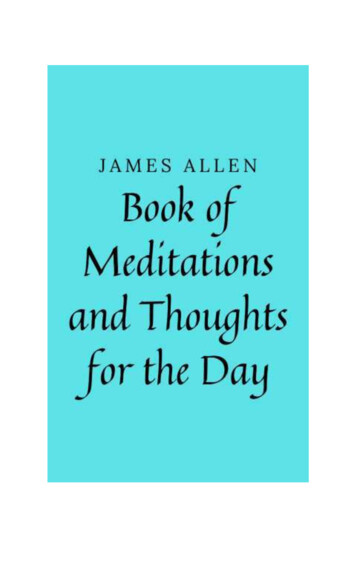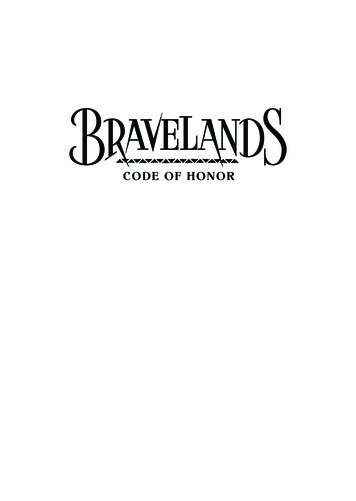
Transcription
ABOUT THE BOOKLao-tzu, the legendary sage of ancient China, istraditionally considered to be the author of the Tao TeChing, one of the most popular classics of worldliterature. Now Lao-tzu’s further teachings on the Tao,or Way, are presented here in the first Englishtranslation of the Chinese text known as the Wen-tzu.Although previously ignored by Western scholars, theWen-tzu has long been revered by the Chinese as oneof the great classics of ancient Taoism. In it, Lao-tzushows that the cultivation of simplicity andspontaneity is essential to both the enlightenedindividual and the wise leader. This timeless work willappeal to a broad audience of contemporary readerswho have come to consider Lao-tzu’s Tao Te Ching aclassic on the art of living.THOMAS CLEARY holds a PhD in East AsianLanguages and Civilizations from Harvard Universityand a JD from the University of California, Berkeley,Boalt Hall School of Law. He is the translator of overfifty volumes of Buddhist, Taoist, Confucian, andIslamic texts from Sanskrit, Chinese, Japanese, Pali,
and Arabic.
Sign up to learn more about our books and receivespecial offers from Shambhala Publications.Or visit us online to sign up atshambhala.com/eshambhala.
Wen-tzuUnderstanding the MysteriesLao-tzuTranslated by Thomas ClearySHAM BHALABoston & London2013
Shambhala Publications, Inc.Horticultural Hall300 M assachusetts AvenueBoston, M assachusetts 02115www.shambhala.com 1991 by Thomas ClearyCover art: Dragons Painted in Ink by Chen Rong. Painting on silk, Song dynasty.Reproduced by permission of the Commercial Press (Hong Kong) Limited from TheArt of the Dragon.All rights reserved. No part of this book may be reproduced in any form or by anymeans, electronic or mechanical, including photocopying, recording, or by anyinformation storage and retrieval system, without permission in writing from thepublisher.Library of Congress Cataloging-in-Publication DataWen tzu. English.Wen-tzu: understanding the mysteries/by Lao Tzu. translated by Thomas Cleary.p. cm.—(Shambhala dragon editions)Originally published: Further teachings of Lao-tzu, c1991.eISBN 978-0-8348-2694-6ISBN 978-0-87773-862-6 (pbk. : alk. paper)I. Cleary, Thomas F., 1949– . II. Title. III. Series.[BL1900.W462E5 1991] 92-53700181′.114—dc20CIP
ContentsTranslator’s IntroductionHistorical Background of the Wen-tzu in the TaoistTraditionTeachings of the Wen-tzu: Further Sayings of Lao-tzuWen-tzuE-mail Sign-Up
IntroductionHistorical Background of the Wen-tzuin the Taoist TraditionThe Wen-tzu, also known by the honorific titleUnderstanding the Mysteries, is one of the greatsourcebooks of Taoism, written more than two thousandyears ago. Following the tradition of Lao-tzu, Chuang-tzu,and the Huainan Masters, the Wen-tzu covers the wholerange of classical Taoist thought and practice. Longneglected by all but initiates, with this English translationthe work is now available in a Western language for the firsttime.The Wen-tzu presents a view of Taoism that is quitedifferent from that projected by Western scholars and morein accord with Taoist conceptions. Its compilation isattributed to a disciple of Lao-tzu, reputed author of theclassic Tao Te Ching, and most of its contents areattributed to Lao-tzu himself. The assignment of authorshipin ancient Taoism is generally symbolic rather than
historical. Names may refer not only to supposedindividual persons, but also to schools and traditionsassociated with those individuals or their circles.According to Taoist tradition, the ancient sage Lao-tzuwas not an isolated individual but a member of an esotericcircle. He is believed to have had several disciples, to eachof whom he passed on a collection of ancient Taoistteachings. The book known as the Wen-tzu is one suchcollection, elaborating on the teachings of the Tao TeChing in a series of discourses attributed to the ancientmaster Lao-tzu.The author of the Wen-tzu is supposed to have advisedKing P’ing of the Chou dynasty, who lived in the eighthcentury B.C.E. This is hundreds of years before Lao-tzu isbelieved to have lived, but this dating of the text is purelysymbolic. It was during the reign of King P’ing that thereigning house of Chou divided and started to lose the lastof its dynastic integrity. After King P’ing, the vassal statesbegan to assert themselves and struggle for hegemony. Thesymbolic dating of the Wen-tzu therefore indicates that itaddresses the needs and problems of an age of transitionand uncertainty.As is the case with other Chinese classics, the earlyhistory and transmission of the book of Wen-tzu wasobscured by the holocausts of the warring states era leadingup to the founding of the first empire in the third century
B.C.E.The first public notice of the disciple of Lao-tzu whorecorded the book is found in Records of the GrandHistorian, a standard historical work by the eminent Ssuma Ch’ien (ca. 145–90 B.C.E.).A nine-chapter version of the Wen-tzu is noticed in ahistorical work of the first century C.E., where it is listedamong texts existing in the earlier Han dynasty (ca. 200B.C.E–8 C.E.). A twelve-chapter version is noticed in therecords of the Sui dynasty (581–618 C.E.). During thebrilliant T’ang dynasty (618–905 C.E.), when Taoismflourished under state patronage, the Wen-tzu wasrecognized as an exposition of teachings of the ancientmaster Lao-tzu and given imperial recognition of its statuswith an honorific title identifying it as a classic, T’unghsuan chen-ching (Tongxuan zhenjing), “Scripture ofTruth on Understanding the Mysteries.”From internal evidence it is clear that the spirituallineage of the Wen-tzu is rooted in the Tao Te Ching, theChuang-tzu, and the Huainan-tzu. It follows up andelaborates upon the teachings of all of these ancient works.Shortly after the time of the last-named Taoist classic(second century B.C.E.), the tradition of Lao-tzu’sphilosophical Taoism went largely underground, while HanConfucianism turned to despotism and Han Taoism took tomagic and drugs. The Wen-tzu is therefore one of the veryfew great Taoist classics of the entire Han dynasty; and
even though it predates the turn of the millennium, it isalready one of the last in the ancient philosophical lineageof Lao-tzu and the Tao Te Ching.
Teachings of the Wen-tzu: FurtherSayings of Lao-tzuIn terms of its contents, the Wen-tzu presents adistillation of the teachings of its great predecessors,especially the Tao Te Ching, Chuang-tzu, and theHuianan-tzu. It particularly follows the latter in itsinclusion of selected material from Confucian, Legalist,and Naturalist schools of thought. In addition, the Wen-tzualso contains a tremendous amount of other proverbial andaphoristic lore that is not to be found in its predecessors.Most of the sayings in the Wen-tzu are identified asfurther sayings of Lao-tzu, the Old Master representing theauthorship of the Tao Te Ching, symbolizing the lineage ofthe text. A version of Lao-Tzu’s work called Lao-tzu Te TaoChing was studied by certain early Legalists andConfucians, and the Taoist form of the classic was studiedby Naturalists, and as a follower of the comprehensivetradition of the classical period of Lao-tzu studies, theWen-tzu touches upon the relationships among ideas of thevarious schools.The philosophy of the Wen-tzu is given a historicalsetting in order to illustrate its point of view and its
relevance to specific human concerns. The perception ofthe human race and its history presented in the Wen-tzu isto some extent typical of classical Taoism, but it also hasan individuality in accord with its own position in time,having appeared aftercenturiesofprofounddisillusionment. The Wen-tzu’s description of the fall ofhumankind from pristine purity provides a traditionalframework for the articulation of Taoist ideas. Chapter 172of the Wen-tzu begins in such a manner:In high antiquity, real people breathed yin and yang,and all living beings looked up to their virtue, thusharmonizing peacefully. In those times, leadership washidden, spontaneously creating pure simplicity. Puresimplicity had not yet been lost, so myriad beingswere very relaxed.The expression real people frequently encountered inTaoist lore, is particularly prominent in the classicsChuang-tzu and Huainan-tzu. Technically, it refers to aTaoist adept of a certain level of attainment; generallyspeaking, real people are those who have realized the Taoistideal of freedom from artificialities. To say that they“breathed yin and yang,” the creative energies of theuniverse circulating within them, bespeaks the intimacy anddirectness of the relationship between real people andNature.
Typically, this closeness with Nature herself is alsoreflected in the quality of the relationship real peopleenjoy with other beings. The concealment of the leadershipof real people in unobtrusive spontaneity is acorrespondingly common Taoist idea, whose classicexpression is to be found in the Tao Te Ching: “Very greatleaders in their domains are only known to exist.”The real people are believed to be hidden naturally, notbecause they are secretive in the ordinary sense of theword, but because they do not aggrandize themselves orcall attention to themselves. Their pure simplicity isspontaneous and unobtrusive, so they foster no divisionsand create no tensions. The Tao Te Ching says, “When thegovernment is noninvasive, the people are very pure.”Chapter 172 of the Wen-tzu goes on to recount the firststages of the deterioration of human society andconsciousness.Eventually society deteriorated. By the time of FuHsi, there was a dawning of deliberate effort;everyone was on the verge of leaving their innocentmind and consciously understanding the universe.Their virtues were complex and not unified.Fu Hsi is the earliest of the prehistoric culture heroes ofChina commonly named in Taoist literature. No specificdates are ever ventured for him in Chinese tradition, as Fu
Hsi is believed to have lived before the development ofagriculture. He is associated with the origins of animalhusbandry, and therefore his era is reckoned as one of verygreat antiquity.Fu Hsi is also said to have invented the original symbolsof the classic I Ching, or Book of Change, using them as aprimitive form of notation. Based on these items oftraditional description of Fu Hsi, it is clear why the Wentzu now uses this figure as a marker for the incipient lossof primeval human innocence and the beginnings ofconscious knowledge.Wen-tzu continues its recital in chapter 172 withreference to other fabled leaders of antiquity:Coming to the times when Shen-nung and Huang Tigoverned the land and made calendars to harmonizewith yin and yang, now all the people stood straight upand thinkingly bore the burden of looking andlistening. Therefore they were orderly but notharmonious.Shen-nung was also a prehistoric culture hero, creditedwith the development of agriculture and herbal medicine;his wife is said to have begun the practice of silkcultivation and weaving. The Wen-tzu makes a point ofnoting that Shen-nung and his wife both practiced these artspersonally as guides and examples for the people.
Huang Ti, the first of the ancient culture heroes to beplaced in history, is honored as a student and patron of allthe Taoist arts, both exoteric and esoteric, and is creditedwith the authorship of the first book ever written. Thelegend of Huang Ti in particular represents thesubordination of earthly dominion to the quest for freedomand perfection of the spirit. This did not mean completerelinquishment of concern for the world, but a vision ofindividual and social life as vessels of a higher and broaderdevelopment.As in the case of Fu Hsi, no attempt is traditionally madeto place Shen-nung within any sort of definable time frame,even legendary. Huang Ti, in contrast, is believed to havelived in the twenty-seventh century B.C.E, and the Chinesecalendar of years begins from the time of his reign.Accordingly, Huang Ti is the first of the great cultureheroes who is represented as having been taught by humansand not directly by phenomena as had been Fu Hsi andShen-nung. He is depicted as having been a warrior and astatesman, later a mystic and a lover.The condition of the human mind and society in the erasof Shen-nung and Huang Ti, whose idealizations wereordinarily romanticized, are seen from the Taoistperspective of the Wen-Tzu as marked by increasingcomplexity, concern, and potential fragmentation. In theearly Han dynasty (206 B.C.E.–8 C.E.) a number of texts
symbolically attributed to Huang Ti were commonlystudied together with the Tao Te Ching by followers of aninfluential school of political thought known as Huang-Lao,with which the authors of the Wen-Tzu undoubtedly hadcontact.Fu Hsi, Shen-nung, and Huang Ti are sometimes knowncollectively as the Three August Ones mentioned here andthere in the Wen-tzu to represent a certain stage in theevolution of consciousness: “The Three August Ones hadno regulations or directives, yet the people followedthem.” After them, tradition continues, came a series ofrulers known as the Five Lords, who “had regulations anddirectives, but no punishment or penalties.” They werefollowed by the Three Kings, charismatic leaders Yao,Shun, and Yu, whom Confucians regarded as symbols ofvirtuous government.In chapter 172, the Wen-tzu picks up the thread of itsstory of the fall of humankind with the Shang or Yindynasty, which began a thousand years after Huang Ti in theeighteenth century B.C.E. and ended in the twelfth centuryB.C.E.: “Later, in the society of the times of the Shang-Yindynasty, people came to relish and desire things, andintelligence was seduced by externals. Essential life lost itsreality.”The Shang dynasty produced a highly developed materialcivilization, but it also learned to practice slavery and
political mind-control techniques. The fact that it lasted formore than six hundred years may testify to its power, butthe Shang deteriorated and was eventually supplanted by theChou dynasty (1123 B.C.E.–256 B.C.E.), which was the era ofthe Book of Change and the classical masters of Chinesephilosophy, including Kuan-tzu, Sun-tzu, Confucius, and theTaoist giants.Supposed to have originally been written in the eighthcentury B.C.E., when the Chou was beginning to declinemarkedly, the Wen-tzu gives a comparatively lengthydescription of human corruption and degeneracy in themind and society of this “latter-day” era:Coming to the Chou dynasty, we have diluted purityand lost simplicity, departing from the Way to contriveartificialities, acting on dangerous qualities. Thesprouts of cunning and craft have arisen; cynicalscholarship is used to pretend to sagehood, falsecriticism is used to intimidate the masses, elaborationof poetry and prose is used to get fame and honor.Everyone wants to employ knowledge and craft forrecognition in society and loses the basis of theoverall source.Having more probably been written about seven hundredyears later than the time of its attribution, some twohundred years after the final abolition of even the name of
the Chou dynasty, which had moreover been a name withouta reality for many centuries by then, the Wen-tzu speaksfrom the standpoint of a historical perspective on thedirection of Chou society that is naturally broader andmore accurate than that of the much earlier age to which itis symbolically attributed. Thus in its time it derivedauthority from both the antiquity of its tradition and themodernity of its outlook.The human problems addressed in the Wen-tzu wereconcerns articulated by the broad band of philosophers ofChou times: human nature and potential; the relationship ofhumanity to itself and the world; causes and treatments ofsocial dysfunction.Within these general ranges of interest, the Wen-tzudeals extensively with mental and physical health; socialconventions and human behavior; organization and law;statecraft and culture; and the processes of war and peace.In the Taoist world view of the Wen-tzu, mind and bodyare a continuity, within the individual and within society asa whole. Mental and physical health should thereforesupport each other, based on sensitively balanced responseto needs:The way of developed people is to cultivate the bodyby calmness and nurture life by frugality. . . . Togovern the body and nurture essence, sleep and rest
moderately, eat and drink appropriately; harmonizeemotions, simplify activities. Those who are inwardlyattentive to the self attain this and are immune toperverse energies.The frugality and moderation of the ancient Taoistsgoverned not only their consumption of material goods butalso their expenditure of vital energy. Even their materialfrugality was not only an economic measure and a politicalgesture, but also a practical reluctance to expend mentalenergy on superficials. This attitude could therefore beextended to apply to all sorts of uses of attention, which isthe focusing or accumulating of the energy ofconsciousness. The Wen-tzu describes some ways of usingattention that sap the mind-body continuum of the power inits central core:Those who decorate their exteriors harm themselvesinside. Those who foster their feelings hurt theirspirit. Those who show their embellishments hidetheir reality.Those who never forget to be smart for even asecond inevitably burden their essential nature. Thosewho never forget to put on appearances even on a walkof a hundred steps inevitably burden their physicalbodies.Therefore, beauty of feather harms the skeleton,
profuse foliage on the branches hurts the root. No onein the world can have excellence in both.If extravagance and excess were seen as destructive to theindividual, they were considered incomparably more so tosociety and nature. Greed was believed to be the motiveforce behind exploitation and destruction of theenvironment and its inhabitants, including the people caughtup in the frenzy:Rulers of degenerate ages mined mountain minerals,took the metals and gems, split and polished shells,melted bronze and iron; so nothing flourished. Theyopened the bellies of pregnant animals, burned themeadowlands, overturned nests and broke the eggs, sophoenixes did not alight, and unicorns did not roamabout. They cut down trees to make buildings, burnedwoodlands for fields, overfished lakes to exhaustion.The callous rapacity toward nature depicted here could notbut extend its influence into the relationships among thehuman beings competing for the lion’s share, and amongthose fighting for the scraps and leavings of that struggle.The gradual enslavement of both humanity and nature todeliberate contrivance is vividly depicted by the Wen-tzu interms calculated to arouse the self-reflection of the readerin any age:
Mountains, rivers, valleys, and canyons were dividedand made to have boundaries; the sizes of groups ofpeople were calculated and made to have specificnumbers. Machinery and blockades were built fordefense, the colors of clothing were regulated todifferentiate socioeconomic classes, rewards andpenalties were meted out to the good and theunworthy. Thus armaments developed and strugglearose; from this there began slaughter of the innocent.Unlike Legalists and later Confucians under Legalistinfluence, Taoists did not conclude from this sort ofconduct that human nature is in itself evil or possessed of apropensity thereto. They simply concluded that humanbeings can be influenced and conditioned into behavior thatis contrary to their own best interests, and indeed even intothinking that what is harmful to them is actually delightful.This facet of the human psyche is said to be the reason forthe origination of the institution of law:Law does not descend from heaven, nor does itemerge from earth; it is invented through human selfreflection and self-correction. If you truly arrive atthe root, you will not be confused by the branches; ifyou know what is essential, you will not be mixed upby doubts.
For the very reason that its premises are based on qualitiesof human character that may appear in anyone of any socialclass or status, Taoist legalism insists on equality beforethe law in principle and practice. This principle is alsorooted in a sort of operational necessity, the pragmatic factthat law cannot fulfill its function properly or adequatelyunder any other conditions:What is established among the lower echelons is notto be ignored in the upper echelons; what is forbiddento the people at large is not to be practiced byprivileged individuals.Therefore when human leaders determine laws, theyshould first apply them to themselves to test and provethem. So if a regulation works on the rulersthemselves, then it may be enjoined on the populace.Although both recognized law above personality, thereremained a critical distinction between Taoist and nonTaoist legal theory in ancient China. For the Taoist,although the law is above questions of individual socialstatus, still it is not an absolute ruler and ultimately musthave its source in what is right and just for the time, place,and people it is designed to serve; and the letter of the lawitself cannot be its own criterion over time, without theactive interpretation and input of authentic insight:
Laws and regulations are to be adjusted according tothe mores of the people; instruments and machines areto be adjusted according to the changes of the times.Therefore people who are constrained by rules cannotparticipate in the planning of new undertakings, andpeople who are sticklers for ritual cannot be made torespond to changes. It is necessary to have the light ofindividual perception and the clarity of individuallearning before it is possible to master the Way inaction.Those who know where laws come from adapt themto the times; those who do not know the source ofways to order may follow them but eventually wind upwith chaos. . . . To sustain the imperiled and bringorder to chaos is not possible without wisdom. As faras talking of precedents and extolling the ancient areconcerned, there are plenty of ignoramuses who dothat. Therefore sages do not act upon laws that are notuseful and do not listen to words that have not proveneffective.Here the Wen-tzu displays a kind of Taoist thinking that isquite different from the image of antiquarian conservatismsometimes projected by antipathetic scholars looking atfragmentary materials. To understand the different levels ofimpact such statements delivered, it is useful to remember
that in Taoist philosophical writings the word sage meansan enlightened individual and also a wise leader.In the context of statecraft it may be thought toordinarily have the latter meaning, but it also means onewho has the potential to become a wise leader, in otherwords, an enlightened individual.When the meaning of the enlightened individual issingled out, such statements become revolutionary innature. This independent attitude emphasizing objectiveknowledge over conventional conformity eventually forcedphilosophical Taoism to go underground with theestablishment of Confucian orthodoxy in the early Handynasty. When formal scholarship had become part of amechanism of exploitation and self-aggrandizement, Taoistthinkers went their own way; hiding their names, theypublished scathing critiques of corrupt government, likethe Wen-tzu’s description of a sick society:The governments of latter-day society have not storedup the necessities of life; they have diluted the purityof the world, destroyed the simplicity of the world,and made the people confused and hungry, turningclarity into murkiness. Life is volatile, and everyone isstriving madly. Uprightness and trust have fallen apart,people have lost their essential nature; law and justiceare at odds. . . .
Early Taoists and Confucians both observed that excesssatiety and excess want, which coexisted because ofimbalance in the structure and function of society, tendedto distort the human mind even further and foster violenceand despair. Therefore both schools recognized theinterdependence of human problems, seeing thatpsychological and social problems had a basis in economicconditions, while economic problems had a basis inpsychological and social conditions. Taoist politicalthinking strives to take both sides of the circle intoaccount:If there is more than enough, people defer; if there isless than enough, they compete. When they defer, thencourtesy and justice develop; when they compete, thenviolence and confusion arise. Thus when there aremany desires, concerns are not lessened; for thosewho seek enrichment, competition never ceases.Therefore, when a society is orderly, then ordinarypeople are persistently upright and cannot be seducedby profits or advantages When a society is disorderly,then people of the ruling classes do evil but the lawcannot stop them.Competition gone to extremes becomes conflict, a subjectof central concern to the classical Taoist philosophers. The
Wen-tzu recapitulates Lao-tzu’s Tao Te Ching on thesubject of warfare, recognizing that the economic cost ofwar translates directly into human cost above and beyondthat of the dead, wounded, widowed, and orphaned:Lordly kings enrich their people, despotic kingsenrich their lands, nations in danger enrich theirbureaucrats. Orderly nations appear to be lacking, lostnations have empty storehouses. Therefore it is said,“When rulers don’t exploit them, the people naturallygrow rich; when the rulers don’t manipulate them, thepeople naturally become civilized.”When you mobilize an army of one hundredthousand, it costs a thousand pieces of gold per day;there are always bad years after a military expedition.Therefore armaments are instruments of ill omen andare not treasured by cultured people. If you reconcilegreat enemies in such a way that some enmityinevitably remains, how unskillfully you have done it!Elsewhere the Wen-tzu goes even further than Tao TeChing in depicting the horrors wrought by a benighted andwarlike society, summing up the classical Taoist teachingon the subject of human degeneracy:Rulers and subjects are at odds and not on friendlyterms, while relatives are estranged and do not stick
together. In the fields there are no standing sprouts, inthe streets there are no strollers. Gold lodes arequarried out, gem-stones are all taken, tortoises arecaptured for their shells and have their belliesremoved. Divination is practiced every day; the wholeworld is disunited. Local rulers establish laws that areeach different, and cultivate customs that are mutuallyantagonistic. They pull out the root and abandon thebasis, elaborating penal codes to make them harsh andexacting, fighting with weapons, cutting downcommon people, slaughtering the majority of them.They raise armies and make trouble, attacking citiesand killing at random, overthrowing the high andendangering the secure. They make large assaultvehicles and redoubled bunkers to repel combattroops and have their battalions go on deadly missions.Against a formidable enemy, of a hundred that go, onereturns; those who happen to make a big name forthemselves may get to have some of the annexedterritory, but it costs a hundred thousand slain incombat, plus countless numbers of old people andchildren who die of hunger and cold. After this, theworld can never be at peace in its essential life.Fortunately, even while Taoist thinkers did not shrink fromsuch frank criticism of the society in which they lived, the
degradation of human values that they witnessed did notinduce in them cynicism or despair. Like Buddhists, theyfocused on human problems to stimulate themselves tofind solutions.The Wen-tzu proposes the possibility of freedom anddignity, for the individual and for humanity as a whole. Butfreedom and dignity are not without a price, not withoutresponsibilities to the foundations of their very existence.In order to see what the bases of freedom and dignity are,the Wen-tzu guides the thinker through the elementalpatterns and reasons underlying the natural order and itsreflections in human needs and human behavior.The Way of Taoism is called simple and easy because itis not as complicated as a culture of manners andappearances, and it is not as hard as a culture of conflictand contentiousness. In its sophistication andcomprehensive scope, combined with an accessible formatand easy style, the Wen-tzu is a crowning work of earlyTaoism. Like the other classics, its way does not admit ofdefinition by a few clichés, but it does offer many usefulsummaries of what a Taoist considers a sensible way oflife.One of the simplest sets of statements in the Wen-tzu,on three kinds of unnatural death, demonstrates theinterpenetration of the individual, professional, social, andpolitical dimensions of Taoist practice. The Wen-tzu’s
description of these three kinds of unnatural death containswithin itself the way to avoid them and live life to the full:There are three kinds of death that are not naturalpassing away: If you drink and eat immoderately andtreat the body carelessly and cheaply, then illnesseswill kill you.If you are endlessly greedy and ambitious, thenpenalties will kill you. If you allow small groups toinfringe upon the rights of large masses, and allow theweak to be oppressed by the strong, then weapons willkill you.The Wen-tzu also speaks of four practices through which“the way of government is comprehended,” meaning theway of individual self-government as well as the way ofgovernment of nations:Find out destiny, govern mental functions, makepreferences orderly, and suit real nature; then the wayof government is comprehended. Find out destiny, andyou won’t be confused by calamity or fortune. Governmental functions, and you won’t be joyful or angry atrandom. Make preferences orderly, and you won’tcrave what is useless. Suit real nature, and yourdesires will not be immoderate.When you are not confused by calamity or fortune, pa
teachings. The book known as the Wen-tzu is one such collection, elaborating on the teachings of the Tao Te Ching in a series of discourses attributed to the ancient master Lao-tzu. The author of the Wen-tzu is supposed to have advised King P’ing of the Chou dynasty, who lived in the eighth century B.C.E.











